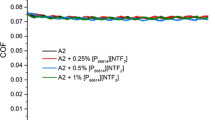Abstract
Volatile organic contamination is known to be one of the factors to cause the failure of head-disk interface (HDI). Therefore, reduction of its harmful effects and improvement of the stability and reliability of HDI is becoming an important issue. In this study, the effects of some model compounds of volatile organic contamination on the tribological characteristics of HDI were systematically investigated using a contact start/stop (CSS) tester. The slider surface after the CSS tests was analyzed using Time-of-Flight Secondary Ion Mass Spectroscopy (TOF-SIMS). Transfer of lubricating oil onto the slider surface was detected after the CSS tests. The organic contaminants promoted the transfer and resulted in high and unstable friction force. Fluorinated self-assembled monolayers (SAMs) were applied on the slider surface for reducing the transferred amount of the lubricating oil. Tribological performance of the slider coated with the SAMs and the transfer amount of lubricating oil onto the slider surface in the presence of contaminant was investigated. The friction force was low and stable in the case of the SAMs coated slider even under environmental contaminant. This result could be explained by the reduction of the transferred lubricating oil because the SAMs that coated on the slider surface were low surface energy.











Similar content being viewed by others
References
L. Nebenzahl, R. Nagarajan, J.S. Wong, L. Volpe and G. Whitney, J. The IEST 31 (1998)
T. Yamamoto, M. Takahashi and M. Shinohara, Trib. Mech. Magn. Storage Syst. STLE-29 (1990) 91
S. Fukushima, D. Mizutani, T. Yagishita and T. Kitakohji, ISTFA 519 (1991)
Segar P.R., Jesh M.S., (1999) J. Info. Storage Proc. Syst. 1:125
Golden P., Smallen M., Mee P., (1995) Adv. Info. Storage Syst. 7:193
Volpe L., Gitis N., Brown C., (1992) Adv. Info. Storage Syst. 4:277
R. Koka Microcontamination Sept./Oct. (1993) 41
Koka R., (1995) Trib. Trans. 38:410
Jesh M.S., Segar P.R., (1999) Trib. Trans. 42:310
Smallen M.J., Mee P.B., (1999) J. Info. Storage Proc. Syst. 1:265
Toxen A.M., Smallen M., Golden P., Mee P., (1995) Adv. Info. Storage Proc. Syst. 1:29
Fowler D.E., Geiss R.H., (2000) IEEE Trans. Magnet. 36:133
Wolter R.F., Raman V., Jen D., Gillis D., (1999) J. Info. Storage Proc. Syst. 1:33
Fowler D.E., Geiss R.H., Eldridge D., Schreck E., (1999) IEEE Trans. Magnet. 35:2409
Aruga K., (2001) Fujitsu Sci. Tech. J. 37:126
Syracuse Research Corporation (SRC) database
Ulman A., (1991) An Introduction to Ultrathin Organic Films from Langinuir-Blodgett to Self-assembly. Academic Press, San Diego
Choi J., Ishida T., Kato T., Fujisawa S., (2003) Trib. Int. 36:285
Cong P., Kubo T., Nanao H., Minami I., Mori S., (2005) Trib. Lett. 19:299
Acknowledgments
The authors highly acknowledge the financial support from Storage Research Consortium (SRC), and for supplying all slider and disk specimens.
Author information
Authors and Affiliations
Corresponding author
Rights and permissions
About this article
Cite this article
Mori, S., Cong, P., Kubo, T. et al. Effect of volatile organic contamination on head-disk interface tribology and a method for its reduction. Tribol Lett 23, 145–154 (2006). https://doi.org/10.1007/s11249-006-9110-z
Received:
Accepted:
Published:
Issue Date:
DOI: https://doi.org/10.1007/s11249-006-9110-z




